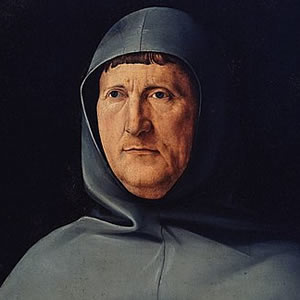It’s common modern practice to consider art and commerce in opposition to each other, and artists and accountants as cartoonish polar opposites, as well. But it wasn’t always so. About 520 years ago, art and commerce, artist and accountant, lived with and learned from each other through the lives of Luca Pacioli and an up-and-comer named Leonardo da Vinci.

Portrait of Luca Pacioli, attributed to Jacopo de’ Barbari, c. 1495.
Da Vinci was, of course, the evolving archetype of the “universal genius,” blazing trails as an inventor, painter, sculptor, musician, anatomist, astronomer, and on and on. Pacioli was a scholar, teacher, and bestselling author in mathematics and geometry who had, among other things, clarified and codified double-entry bookkeeping.
Da Vinci had taught himself mathematics and linear perspective from Pacioli’s Summa de arithmetica, geometria, proportioni et proportionalita, first printed in 1494. Two years later, da Vinci convinced his patron to invite Pacioli to Milan as part of an early “creative placemaking” initiative. While there, the two learned from and supported each other: Pacioli advised da Vinci on perspective and proportion for his large commission of the time, The Last Supper; da Vinci provided illustrations for Pacioli’s second book, the De devina proportione, an early treatise on perspective in painting. Following the French invasion of Milan in 1499, the two escaped to Mantua, where they shared a house for several years.
Da Vinci’s impact on art, science, and culture are well known. But Pacioli’s contributions were comparably transformative. He combined experience in commercial and university mathematics with scholarship in Greek and medieval Latin math as well as Hindu and Arabic innovations, such as arithmetic, algebra, and the ten digits 0 through 9. He published early advances in perspective, including the “Golden Ratio,” that da Vinci and others used to transform visual art and architecture.
But Pacioli is most famous (certainly among CPAs) for a 27-page section of his Summa, where he explained, systematized, and extended the bookkeeping practices of Venice, popularizing the double-entry accounting system that still defines modern commerce. The larger book was among the first blockbusters of the publishing world, among the first to get an author’s copyright (and an extension for the second printing), and among the first to be written in vernacular rather than Latin (Pacioli wrote: “I have written it so that it may bring advantage and pleasure to those who in literature are learned or not”).
In a wider frame, both da Vinci and Pacioli transformed how we humans consider and conceive our individual relationships with the wider world. Through perspective in painting and architecture, da Vinci put the individual in direct relation to nature and the built environment, initiating “point of view” as a core principle of human thought and experience. Through double-entry accounting, Pacioli put individuals and institutions in direct relation to the dynamic systems of their businesses, initiating profit and loss, the income statement, and the balance sheet as means to measure and monitor a firm’s success.
In short, da Vinci helped bring us a new perspective on self, while Pacioli helped bring us a new perspective on wealth. We’ve been building on (and untangling) the implications ever since.
Source for much of the above: Gleeson-White, Jane. Double Entry: How the Merchants of Venice Created Modern Finance. 1st edition. New York: W. W. Norton & Company, 2012.

